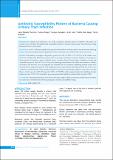Please use this identifier to cite or link to this item:
https://hdl.handle.net/20.500.14356/1046Full metadata record
| DC Field | Value | Language |
|---|---|---|
| dc.contributor.author | Sherchan, Jatan Bahadur | - |
| dc.contributor.author | Dongol, Anjana | - |
| dc.contributor.author | Humagain, Sanjaya | - |
| dc.contributor.author | Joshi, Anish | - |
| dc.contributor.author | Magar, Siddha Rana | - |
| dc.contributor.author | Bhandari, Sarita | - |
| dc.date.accessioned | 2023-04-20T09:47:16Z | - |
| dc.date.available | 2023-04-20T09:47:16Z | - |
| dc.date.issued | 2022 | - |
| dc.identifier.citation | SherchanJ. B., DongolA., HumagainS., JoshiA., Rana MagarS., & BhandariS. (2022). Antibiotic Susceptibility Pattern of Bacteria Causing Urinary Tract Infection. Journal of Nepal Health Research Council, 20(01), 218-224. https://doi.org/10.33314/jnhrc.v20i01.4142 | en_US |
| dc.identifier.issn | Print ISSN: 1727-5482; Online ISSN: 1999-6217 | - |
| dc.identifier.uri | http://103.69.126.140:8080/handle/20.500.14356/1046 | - |
| dc.description | Original Article | en_US |
| dc.description.abstract | Abstract Background: Urinary tract infection is one of the commonest infectious diseases worldwide. This study was carried out to determine the antimicrobial susceptibility pattern of bacteria causing urinary tract infection visiting Kathmandu University Hospital. Methods: A total of 3,500 urine samples were processed and antibiotic resistance pattern was determined following Clinical Laboratory Standard Institute guidelines. Patients’ information was obtained after informed consent. Results: Total number of samples with positive growth was 434 (12.40%). 331 (76.27%) of the isolates were Escherichia coli followed by Klebsiella pneumoniae, Enterococcus spp., Pseudomonas aeruginosa, Staphylococcus saprophyticus, Proteus mirabilis, Enterobacter species, Klebsiella oxytoca, Citrobacter freundii, Proteus vulgaris, Staphylococcus aureus and Acinetobacter species. Over all 224 (51.61%) were multidrug resistant strains. All strains were sensitive to colistin, vancomycin and linezolid. Over all ampicillin and cefazolin had least sensitivity. Multidrug resistant strains were detected more among elderly patients with complicated urinary tract infection and diabetes which was 25 (83.33%) compared to elderly patients with uncomplicated urinary tract infection and having no diabetes or any other comorbid illnesses which was only 11(22.22%) (p-value<0.05). 21 (70.00%) of the pregnant females had multidrug resistant isolates and only 18 (36.73%) of pediatric age group patients had multidrug resistant isolates (p-value<0.05) Conclusion: Drug-resistant bacteria were observed in urine samples. Effective treatment and prevention of urinary tract infection need detailed microbiological diagnosis and drug susceptibility testing. Keywords: ESBL; MDR; UTI | en_US |
| dc.language.iso | en | en_US |
| dc.publisher | Nepal Health Research Council | en_US |
| dc.relation.ispartofseries | Jan-March, 2022;4142 | - |
| dc.subject | ESBL | en_US |
| dc.subject | MDR | en_US |
| dc.subject | UTI | en_US |
| dc.title | Antibiotic Susceptibility Pattern of Bacteria Causing Urinary Tract Infection | en_US |
| dc.type | Journal Article | en_US |
| local.journal.category | Original Article | - |
| Appears in Collections: | Vol. 20 No. 01 (2022): Issue 54 Jan-March, 2022 | |
Files in This Item:
| File | Description | Size | Format | |
|---|---|---|---|---|
| 4142-Manuscript-27896-1-10-20220606.pdf | Fulltext Download | 254.05 kB | Adobe PDF |  View/Open |
Items in DSpace are protected by copyright, with all rights reserved, unless otherwise indicated.
